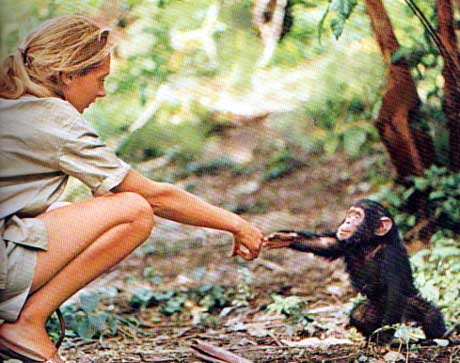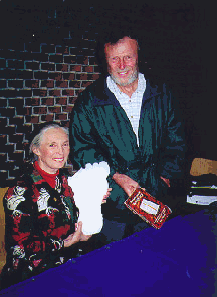
May 28, 2007
Yeti or Bigfoot or Sasquatch….I tell you that I’m sure that they exist….I’ve talked to so many Native Americans who all describe the same sounds, two who have seen them. I’ve probably got about, oh, thirty books that have come from different parts of the world, from China from, from all over the place.Dr. Jane Goodall, while being interviewed by Ira Flatow, National Public Radio’s “Science Friday,” September 27, 2002.

Of late, while talking about women in Bigfoot studies, I ventured off into writing about women in racing and mentioning briefly Jane Goodall as a woman whose entry into the man-dominated field of anthropology and primatology was made somewhat easier by her self-promotion and her photographs. Few people realize today how dynamically Jane Goodall used her sense-of-self to get what she wanted in her desire to study the great apes.
Most online quickie biographies of Jane Goodall simply say that her father was an engineer and her mother was an author.
The deeper realities are much more revealing.
Coincidentally to my recent posts about the Indy 500, Jane Goodall’s father, Mortimer Herbert Morris-Goodall was a professional race car driver. Morris-Goodall, in 1930-1931, first drove his own personal Aston Martin International, then after mid-1931, he raced Aston Martin’s seventh Le Mans racer (the LM7, painted a “sweet olive green” to identify Morris-Goodall’s British nationality).
Mortimer Morris-Goodall, as a youth, was in the military stationed in the jungles of Singapore. Jane Goodall vividly recalls a gift her father gave her when she was about a year old. She still treasures it today. It is a toy chimpanzee named Jubilee after a famous chimpanzee at the London Zoo back then.

Her mother Margaret Myfanwe Joseph, when she first met Morris-Goodall, was a secretary for the impresario Charles B. Cochran. Vanne, as she was called, was said, in those days, to have a “striking combination of fine arches and curves in the face, a warm and confident smile, high bright cheeks, and a firm jaw.” She is remembered as a “green-eyed goddess” who had a strong and supportive impact on her daughter. Her mother would read often from Kipling’s The Jungle Book when Jane was a child.
Mortimer and Vanne divorced and Jane remained with and was raised by her mother and grandmother. Vanne would assist her daughter’s dreams come true. On July 16, 1960, when Jane Goodall finally made the boat trip to Gombe to study chimpanzees, her mother was along for the trip and without medical skills, Vanne sat up a health clinic for the locals.

The rest, as they say, is history.
Author Florence Williams gives a hint of this legacy in her short review of the first biography to ever appear about Jane Goodall, published in 2006:
The British yen for adventure found a very different vessel in the young secretary who changed the science of animal behavior. In Jane Goodall: The Woman Who Redefined Man (Houghton Mifflin, $35), Dale Peterson…vividly captures his subject’s idealism and derring-do. In 1957, 22-year-old Goodall lit out for Africa, and she was soon taking dictation for visionary archaeologist Louis Leakey. Before becoming his star protegée, Peterson writes, she fended off the married scientist’s sexual advances. Men everywhere fell in love with Goodall, but it was the primates in what is now Tanzania’s Gombe Stream National Park who earned her steadiest gaze; she would sit among the animals until, after years, they ignored her. Her discoveries that chimps ate meat and used tools “constituted a complete validation of . . . her untrained and possibly eccentric approach,” Peterson writes in this readable if worshipful portrait.Florence Williams, Outside Magazine, December 2006

In recent years, through her Jane Goodall Institute, Goodall has continued her chimpanzee and related conservation efforts.

Also, Jane Goodall, due to her remarkable visibility, continues to give Bigfoot/Sasquatch supportive statements, so much so that many in the general public consider her to be the most famous female celebrity spokesperson for the reality of unknown hairy hominoids. She still understands the role of her public presence in gaining support for her causes.

Dr. Jane Goodall appears with Dr. John Bindernagel, in support of his 1998 book, North American’s Great Ape: The Sasquatch.
About Loren Coleman
Loren Coleman is one of the world’s leading cryptozoologists, some say “the” leading living cryptozoologist. Certainly, he is acknowledged as the current living American researcher and writer who has most popularized cryptozoology in the late 20th and early 21st centuries.
Starting his fieldwork and investigations in 1960, after traveling and trekking extensively in pursuit of cryptozoological mysteries, Coleman began writing to share his experiences in 1969. An honorary member of Ivan T. Sanderson’s Society for the Investigation of the Unexplained in the 1970s, Coleman has been bestowed with similar honorary memberships of the North Idaho College Cryptozoology Club in 1983, and in subsequent years, that of the British Columbia Scientific Cryptozoology Club, CryptoSafari International, and other international organizations. He was also a Life Member and Benefactor of the International Society of Cryptozoology (now-defunct).
Loren Coleman’s daily blog, as a member of the Cryptomundo Team, served as an ongoing avenue of communication for the ever-growing body of cryptozoo news from 2005 through 2013. He returned as an infrequent contributor beginning Halloween week of 2015.
Coleman is the founder in 2003, and current director of the International Cryptozoology Museum in Portland, Maine.
Filed under Bigfoot, Books, Cryptomundo Exclusive, Cryptotourism, CryptoZoo News, Cryptozoologists, Cryptozoology, Media Appearances, Photos, Pop Culture, Reviews, Sasquatch, Yeti, Yowie